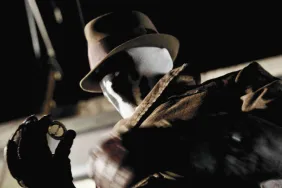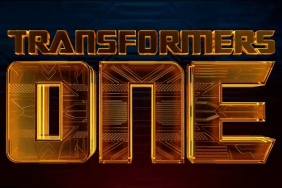Emoji Movie director Tony Leondis talks to ComingSoon.net
ComingSoon.net had the opportunity to chat with The Emoji Movie director Tony Leondis about making the upcoming family film from Sony Pictures Animation. The animated film will open in theaters on July 28.
Hidden within the messaging app is Textopolis, a bustling city where all your favorite emojis live, hoping to be selected by the phone’s user. In this world, each emoji has only one facial expression – except for Gene (T.J. Miller), an exuberant emoji who was born without a filter and is bursting with multiple expressions. Determined to become “normal” like the other emojis, Gene enlists the help of his handy best friend Hi-5 (James Corden) and the notorious code breaker emoji Jailbreak (Anna Faris). Together, they embark on an epic “app-venture” through the apps on the phone, each its own wild and fun world, to find the Code that will fix Gene. But when a greater danger threatens the phone, the fate of all emojis depends on these three unlikely friends who must save their world before it’s deleted forever.
RELATED: T.J. Miller Talks The Emoji Movie
ComingSoon.net: This movie came together very quickly correct?
Tony Leondis: Yes.
CS: Can you tell me about the speedy process of just getting it up and started?
Leondis: We pitched it to Sony with a very clear and simple story. Michele Kouyate’s the producer and I co-wrote it with Eric Siegel, John Hoffman, and also Mike White, who did a great pass on it. We knew that if we were going to make this, since it’s about emojis and technology, that we can’t take five, six years because everything will be outdated. Emojis might be popping up as holograms in six years! Who the heck knows?

CS: Were there any competing projects?
Leondis: Hmm, I don’t think so. Although I think someone pitched an emoji movie after we sold it to Michelle. But no, there were no competing projects, so we had that clear path. It was about finding that very simple journey for [the main character] Gene and then sticking to that. It was not like a lot of those animated movies where you work for five, six years and find the story. We knew we couldn’t do that with this kind of property – we had to have it locked down. So we pitched a very tight story and the studio loved that story and they let us make that movie. That is just everything when the studio lets you make your movie.
CS: Do you still have a little bit of wiggle room, were you able to test the boards with an audience? Or was it too quick?
Leondis: It was too quick. We did have some previews thank God, and they went well and we could make changes but not overhaul the whole movie. It was never one of those. The studio believed in the vision and they let us make it and luckily it worked out.
CS: It’s interesting because there are a lot of scenes where kids addictions to their phones is pronounced. Do you hope that maybe kids will come away from the movie and put their phones in their pockets more?
Leondis: Yes. At the end of the story it’s that emojis can help us connect. But then after that it is about putting your phone down and really connecting with people. What I love about emojis in this technological age is that we found a way to reach out emotionally to other people. That’s what I love about emojis, and it really is how it helps us with the human connection, not hurt us. For instance when I get an emoji from my mom it still makes me happy and it means something when I get the little kissy face. Somehow it really does. But yes, it is about the human connection and we emphasize that in the movie.
CS: TJ [Miller] made a big point that the film is very progressive in the sense of being an outsider where you don’t have to define your personality.
Leondis: Yeah, I think in today’s world the idea of “other” and exclusion is a really difficult discussion we are having right now. And the best animated movies have that allegory of what is happening in the world. But then it’s also told metaphorically through one character’s journey. So that’s the big idea down deep, “Why can’t we just embrace each other the way we are?” Do we have to exclude, put people in boxes? And they are literally in boxes, these emojis, we have them in, like they sit in the Hollywood Squares boxes waiting to be chosen. So in this world everyone is put into a box and Gene doesn’t fit into the box, and what do you do with that kind of character? This story is about embracing that difference and hopefully people come away from this movie by not wanting to put people in boxes and embracing their differences. That’s really what this is about.

CS: I’m a big animation buff, and I feel like anytime I read an interview with a professional voice actor, their number one pet peeve is when they cast a celebrity instead of a professional voice actor. But the thing is if you look at TJ’s filmography, he is totally a professional voice actor! That is a huge part of his career. So what is the difference between a TJ Miller and someone who is just a “celeb-a-voice”?
Leondis: I don’t want to be controversial here, but I’ll be honest – it’s all about the performance. I actually prefer to use actors whether they do voice or not. It’s about can they emote? Do they have a clear intention? Can they be truthful in the moment? And some voice actors concentrate on the funny voice – not all of them! I feel like animation is not a genre, you cast the best person for the role, so that’s what I try to do. And that’s what happened with everyone we got: TJ, Anna Faris! She is such a wonderful actress! She breaks your heart in this movie; she is so emotional and strong and her character is all about self identity as well as a woman. And the roles that women were given as emojis when the first set was created [were] very limited. I don’t want to give anything away, but being a woman on the phone, you didn’t have many options, and so she is someone who wants to break out of her own cube as well. And the same with James Corden. When I saw “One Man, Two Guvnors” — that play he was in — he was so brilliant! I thought to myself, “he is that kind of person that could emote so much with just the voice: I want to work with him one day.” For me it’s not about if you can do voices or not, it’s whether you can act or not.
CS: And you are the sole director on this, right?
Leondis: Correct.
CS: Isn’t it interesting that a project that has gone along this fast would just have one director, because a lot of times you see teams working on this sort of thing?
Leondis: Thank you so much, yes. I had someone help me, Conrad Vernon who did “Sausage Party.” He came in and he helped me get some of the sequences up on boards so I could then take them into animation – he’s an old friend. But this was a very singular vision that I had, and the studio trusted me to make it and they have been very supportive luckily. You don’t usually get that chance to make your movie in animation because it’s so collaborative. But of course, I have been working with some of the best people, they are wonderful, I am so lucky.

CS: It is also interesting that there has been a lot of movies like this recently, like “The LEGO Movie” and “Angry Birds” and a few other projects that take something like an intellectual property that makes you think, “how are they going to make a movie of this?” Almost to the point that we expect it now. We almost expect that sort of thing to become a film, so how do you make this one stand out so it is not just a “LEGO” clone?
Leondis: Well it’s certainly not a “LEGO” clone, especially since those guys Phil [Lord] and Chris [Miller] are so great at what they do and only they can do that. I come from Disney, I used to work there and grew up watching the Disney movies. When I was thinking of a new project I thought, “what are the new toys in the world?” And I looked down at my phone and saw emojis and I thought, “oh! These are the new toys.” I mean video games have been done since the eighties with Pac Man and Tron, and we have been looking to video games, but we’ve never gone into a phone. So that seemed to be natural for me with all of these little characters that already exist – and that’s what you want to find in animation. Characters that exist so people have some type of context with them and then a world that is new that you can “unlock.” So I worried about telling the best story I could with this. You can’t worry if your movie is like this one or that one because everything is like something. Everyone is compared to something, so I just tried to make my movie as authentic as I could.
CS: With what you said earlier about how the movie had to go immediately and was a “right now” type of movie, what do you think are the core elements of the film that will still be relevant 5, 10, 15 years down the line?
Leondis: Thematically, like all the best animated movies we talk about difficult things that challenge people in their lives and we do it all in metaphor. It’s a metaphor about feeling like an outsider and it’s a metaphor about feeling different and other. I think unfortunately that doesn’t seem to be going away, it actually seems like it is getting worse in the world. How we are afraid of “other” and afraid of “different” and I think this is a movie that is trying to say that we are all the same down deep even though we have differences. And I hope that’s something people get from the movie.
The Emoji Movie
-
The Emoji Movie

Fried Shrimp and Gene (TJ Miller) in Columbia Pictures and Sony Pictures Animation's THE EMOJI MOVIE.
-
The Emoji Movie

Akiko Christina Aguilera), Jailbreak (Anna Faris), Hi-5 (James Corden) and Gene (T.J. Miller) in Columbia Pictures and Sony Pictures Animation's THE EMOJI MOVIE.
-
The Emoji Movie

Jailbreak (Anna Faris), Gene (T.J. Miller) and Hi-5 (James Corden) in Columbia Pictures and Sony Pictures Animation's THE EMOJI MOVIE.
-
The Emoji Movie

Alex (Jake T. Austin) in Columbia Pictures and Sony Pictures Animation’s THE EMOJI MOVIE.
-
The Emoji Movie

Gene (TJ Miller) in Texopolis in Columbia Pictures and Sony Pictures Animation's THE EMOJI MOVIE.
-
The Emoji Movie

Ice Cream, Cookie, Poop and Luggage in Columbia Pictures and Sony Pictures Animation's THE EMOJIE MOVIE.
-
The Emoji Movie

Gene (T.J. Miller, left) in Columbia Pictures and Sony Pictures Animation’s THE EMOJI MOVIE.
-
The Emoji Movie

Gene (T.J. Miller) and Hi-5 (James Corden) in Columbia Pictures and Sony Pictures Animation’s THE EMOJI MOVIE.
-
The Emoji Movie

-
The Emoji Movie

-
The Emoji Movie

-
The Emoji Movie

-
The Emoji Movie

-
The Emoji Movie

-
The Emoji Movie










